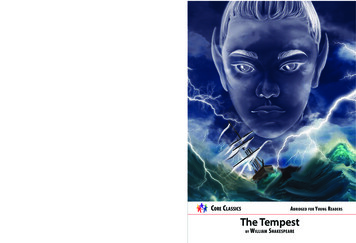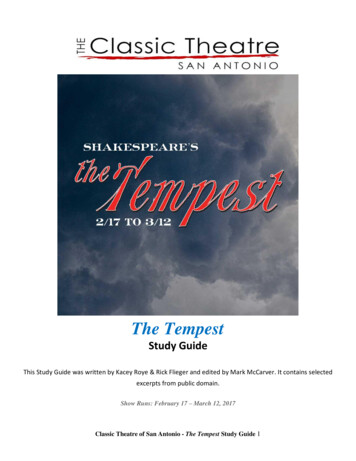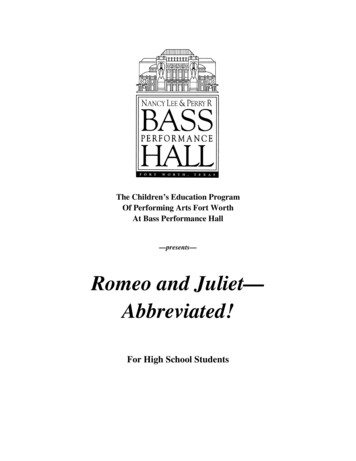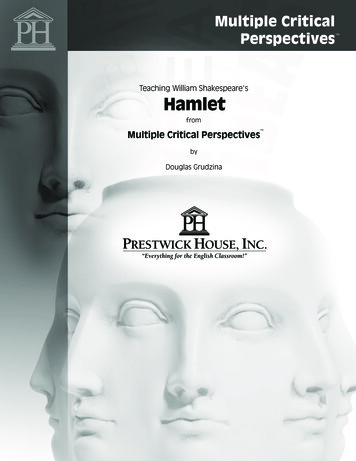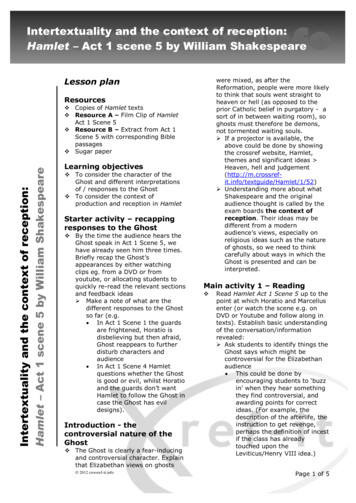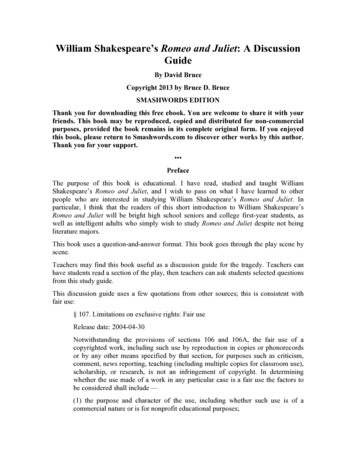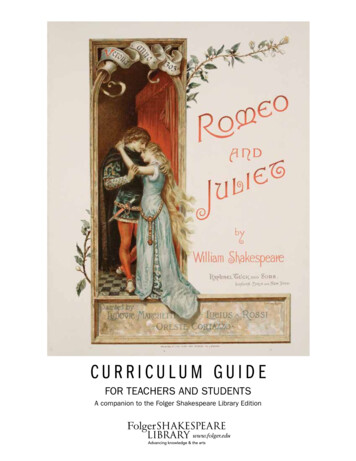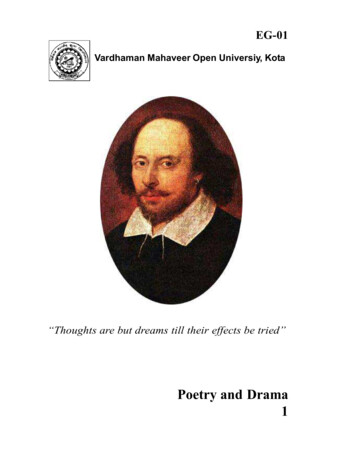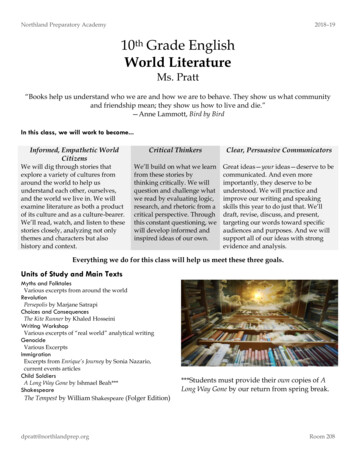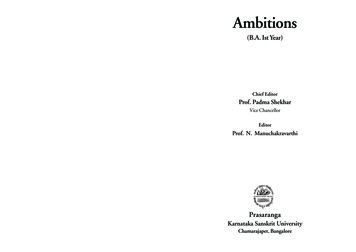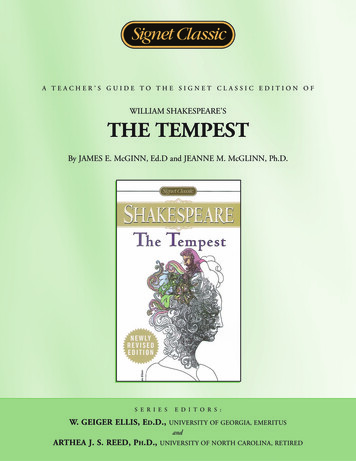
Transcription
A TEACHER’S GUIDE TO THE SIGNET CLASSIC EDITION OFWILLIAM SHAKESPEARE’STHE TEMPESTBy JAMES E. McGINN, Ed.D and JEANNE M. McGLINN, Ph.D.S E R I E SW. GEIGER ELLIS, ED.D.,E D I T O R S :UNIVERSITY OF GEORGIA, EMERITUSandARTHEA J. S. REED, PH.D.,UNIVERSITY OF NORTH CAROLINA, RETIRED
A Teacher’s Guide to the Signet Classic Edition of William Shakespeare’s The Tempest2INTRODUCTIONThe Tempest is generally regarded as Shakespeare’s last play, first performed in 1611 for King James I and again for themarriage festivities of Elizabeth, the King’s daughter, to Frederick, the Elector Palatine. Scholars attribute the immediatesource of the play to the 1609 shipwreck of an English ship in Bermuda and travelers’ reports about the island and theordeal of the mariners. The period in which it was written, the seventeenth century age of exploration, the circumstancesof its performance at court, and the context of the playwright’s writing career suggest immediately some of its rich themesand ambiguities.The play can be read as Shakespeare’s commentary on European exploration of new lands. Prospero lands on an islandwith a native inhabitant, Caliban, a being he considers savage and uncivilized. He teaches this “native” his language andcustoms, but this nurturing does not affect the creature’s nature, at least from Prospero’s point of view. But Prospero doesnot drive Caliban away, rather he enslaves him, forcing him to do work he considers beneath himself and his nobledaughter. As modern readers, sensitive to the legacy of colonialism, we need to ask if Shakespeare sees this as the rightorder; what are his views of imperialism and colonialism? What are our twentieth century reactions to the depiction ofthe relationship between the master and slave, shown in this play?The theme of Utopianism is linked to the explorations of new lands. Europeans were intrigued with the possibilitiespresented for new beginnings in these “new” lands. Was it possible to create an ideal state when given a chance to beginanew? Could humans hope to recreate a “golden age,” in places not yet subject to the ills of European social order? Couldthere be different forms of government? Would humans change if given a second chance in an earthly Paradise?The play emphasizes dramatic effects. Because it was performed at court, there is a lot of stage business: music, dance,masque-like shows. The role of the artist is explored through Prospero’s use of his magic, and parallels can be drawn toShakespeare’s own sense of his artistry.Finally, knowing that this is Shakespeare’s last play, it is intriguing to explore autobiographical connections. Does he seehimself in Prospero? Does he feel somehow isolated, in need of reconciliation? How is this play a culmination of otherthemes he has explored?These questions assume an audience of students who have previously encountered Shakespeare. So, this play will be mostappropriate for high school seniors or college students. The Tempest is an excellent play for study, though, because it showsShakespeare’s final treatment of themes that have run through the other plays, e.g. good and evil, justice and mercy. Inaddition, this play provides a primary source perspective on 17th-century attitudes about imperialism. Students of worldhistory might especially be interested by this view. Also, the low humor and pageantry in the play heightens its appeal toa wider audience. Students might especially have fun with the scenes involving Caliban and the members of the crew.In this guide we will suggest activities and discussion questions which encourage students to explore these various ideas.Since the play may be challenging to high school students, teachers will need to carefully provide students withbackground knowledge in order to insure that their reading and enjoyment of the play is as rich as possible. As in previousTeacher’s Guides to Signet Classics, we include a detailed synopsis of the play and suggested teaching activities for beforestudents read, while they read, and after they read the play. A variety of activities is listed in each section, so the teachercan choose according to the themes, interests, background, and needs of students.OVERVIEWCHARACTERS BY RELATIONSHIPProspero, the true Duke of Milan but now living on a deserted islandMiranda, his daughterAntonio, brother of Prospero and usurper of the role of Duke of MilanAriel, “an airy spirit” who does Prospero’s biddingCaliban, a savage creature controlled by ProsperoAlonso, King of NaplesSebastian, his brotherFerdinand, son of the King of NaplesGonzalo, former advisor to Prospero, now principally serves Alonso
A Teacher’s Guide to the Signet Classic Edition of William Shakespeare’s The Tempest3SYNOPSISACT I, SCENE IThe play begins on the deck of a ship at sea in the middle of a violent tempest. Amid loud sounds of thunder and flashesof lightning, the sailors fight to bring down the sails in order to control the ship. The passengers, Alonso, Sebastian,Antonio, and Ferdinand, come on deck to see what is happening, but the sailors complain that they interfere with theirwork and make more noise than the storm. Soon all appears lost as the ship breaks apart. The passengers and crew believethey are about to drown.ACT I, SCENE IIThe scene changes to the island where Miranda and Prospero have viewed the plight of the storm-tossed ship throughProspero’s magic powers. Removing his magical robe, Prospero tells Miranda the history of her birth and her true placeand value. He describes how he and Miranda, then not quite three years old, were forced to board a rotting ship and putto sea to suffer certain death. The conspiracy to take over Prospero’s power and station was the work of his brother whoplotted with the King of Naples, Prospero’s enemy. Now “by accident most strange,” all these men have been broughtclose to the island where Prospero and Miranda have been shipwrecked for the last twelve years. Through magic and thespirit Ariel who is required to do his bidding, Prospero created the storm and chaos among the sailors and passengers sothat they would be separated and believe the others drowned. However, Prospero has protected them all from harm andhidden the ship under a charm.When Ariel appears reluctant to continue to serve Prospero, he reminds the spirit of its imprisonment by the witchSycorax and Caliban, her child, until Prospero worked his magic. (Ariel’s gender is unspecified.) Besides, Prosperopromises complete freedom in just two days time if Ariel carries out his designs.Prospero awakens Miranda and they visit Caliban, “the slave,” who carries wood, makes fire, and serves their basic needs.Caliban curses Prospero, his master, for usurping his rightful rule of the island, and Prospero vows to punish Caliban forthese insults and his continued insolent behavior. Prospero recalls how when he attempted to befriend Caliban and teachhim language and manners, Caliban tried to “violate the honor” of Miranda.Meanwhile Ariel’s song and music has lured Ferdinand near to Prospero and Miranda. Miranda is immediately impressedby Ferdinand’s good looks, and he is equally smitten by her beauty, calling her a “goddess.” Prospero lets the audienceknow through the vehicle of asides that this attraction is exactly what he had planned and hoped for, and he only actsdisapproving in order to make their bond even stronger. Miranda pleads with her father to spare Ferdinand while Prosperodemands his subservience.ACT II, SCENE IMeanwhile Alonso, Sebastian, Antonio, and Gonzalo have washed up on another part of the island. Gonzalo councilsAlonso to see the optimistic side of their predicament. Even though Ferdinand is missing, they should rejoice that they arealive. This is, of course, the last thing that Alonso wants to hear. Meanwhile Sebastian and Antonio ridicule Gonzalo, makingfun of his speeches. Cruelly, Sebastian even accuses Alonso of being responsible for Ferdinand’s death. They wouldn’t havebeen on this journey if Alonso had allowed his daughter to marry a European prince rather than the King of Tunis.Gonzalo counsels moderation; no one is to blame. He also calls on the company to observe the beauty of the island. Thenhe begins to describe the type of government he would institute on this island. It would be a utopia of equality with nomarks of wealth or social status. All would have leisure and their needs would be met “without sweat or endeavor.”Ariel, who is invisible, passes among the men playing music, and all of the company, except Antonio and Sebastian,suddenly fall into a deep sleep. Antonio uses this moment to describe to Sebastian the opportunity he now has to seizethe crown from his brother.With Alonso’s son and daughter out of the way, Sebastian can easily claim the crown; all he has to do is kill Alonso.Antonio points to his own behavior as a model. He overthrew his brother and now enjoys success. He vows to kill Gonzaloto prevent his interference with their plot while Sebastian kills his brother. Sebastian decides to follow Antonio’s“precedent,” promising Antonio as his reward that he will no longer have to pay tribute to Naples.
A Teacher’s Guide to the Signet Classic Edition of William Shakespeare’s The Tempest4Just as they draw their swords, Ariel awakens Gonzalo, singing in his ear that treachery is at hand. Sebastian and Antonioare able to avoid suspicion by saying that they too had heard a loud noise and were protecting the king. The companynow decides to continue their search for Ferdinand.ACT II, SCENE IIOn another part of the island, a parallel scene occurs between Trinculo, a jester, Stephano, a butler, and Caliban. At firstCaliban hides from Trinculo, fearing he will torment him. For his part Trinculo cannot tell if Caliban is fish or man, butdecides to take shelter in Caliban’s garments because he fears a storm is coming. Stephano, who has found the ship’s liquor,doesn’t know what to make of the “beast” he discovers with four legs, two voices, and a severe case of the shakes. Finally,Trinculo and Stephano discover each other, and Caliban is so impressed with Stephano’s “celestial liquor” that he declareshe will be his subject. Caliban promises to show Stephano all the fine points of the island and to give him food and drink;he vows he will no longer serve Prospero.ACT III, SCENE IFerdinand carries and stacks wood for Prospero, but declares that it is not odious work since he serves a sweet mistress.Miranda laments Ferdinand’s heavy burden and offers to take his place. Prospero, observing this scene from a hiding spot,is happy because it confirms that the two young people are deeply in love. Miranda and Ferdinand declare their affectionsand decide to marry.ACT III, SCENE IICaliban, who is quite drunk, continues to pledge his allegiance to Stephano. The invisible Ariel creates mischief amongCaliban, Stephano, and Trinculo by making it appear that they are contradicting and interrupting each other. Stephanobeats Trinculo for defying Caliban, finally forcing him to stand at a distance while he plots with Caliban to overthrowProspero, marry Miranda, and rule the island. Their conspiracy is interrupted by Ariel’s sweet music when Stephano andTrinculo follow the music in hopes of catching up with the musician.ACT III, SCENE IIIAlonso and his company, exhausted from their search for Ferdinand, decide they must accept the fact that he is drowned.Sebastian quietly vows to Antonio to take advantage of the next opportunity and carry out their coup. Suddenly music isheard and spirits enter with a banquet table and invite all to eat. The men are amazed and wonder if anyone will believetheir stories of these strange events when they return home. Just as they prepare to eat, Ariel arrives in thunder andlightning, looking like a bird of prey, and makes the table disappear. The spirit announces “you are three men of sin” whooverthrew Prospero; the shipwreck is fair punishment. The three men are deeply affected with guilt and anger and run offin different directions. Gonzalo thinks they may harm themselves in their desperation and calls on the rest of the groupto follow them and restrain them if necessary.ACT IV, SCENE IProspero agrees to the betrothal of Miranda and Ferdinand. He explains that the tasks he set were merely trials ofFerdinand’s love, and he has proven to be true. However, Prospero cautions Ferdinand not to give way to his passionsbefore the marriage ceremony.Ariel is sent to gather the whole company while Prospero entertains the young couple with a magic show. Ceres and Junoare called to the earth by Iris to witness a contract of true love. They sing of the blessings to be bestowed on their marriage.Just as nymphs and reapers begin to perform a graceful dance, Prospero rises up in alarm and interrupts the show. He hasjust remembered the conspiracy of Caliban and his confederates.Meanwhile Ariel’s music has led the trio through a maze of briers and mud. Stephano and Trinculo are disgusted and angrywith Caliban who still urges them to kill Prospero. But when they get to Prospero’s home, the men are distracted whenthey see luxurious clothing hanging on a line. They start to fight over the garments and force Caliban to carry what theysteal. Suddenly spirits in the shape of dogs attack them.
A Teacher’s Guide to the Signet Classic Edition of William Shakespeare’s The Tempest5ACT V, SCENE IProspero realizes that his project is almost completed. All his enemies are gathered together in one place. Ariel describesthe sorrow and emotions of the company, adding that anything human would certainly feel compassion for them. Takingthis cue, Prospero decides to show mercy. His reason and not his passion takes control. He realizes that “the rarer actionis in virtue than in vengeance,” and since they are sorry for their crimes, he has accomplished his purpose. Ariel is sent torelease them. Prospero uses his magic one last time to create music to sooth the senses and spirits of the conspirators. Arielfetches Prospero clothes showing his true status as Duke of Milan. When the company revives, Prospero greets them andaccuses them of their crimes. Alonso begs forgiveness and asks about Prospero’s life on the island. Everything would nowbe in order except that Alonso regrets deeply the death of his son. Prospero says he too has suffered a similar loss; he haslost a daughter. Then he bids the company to look into his home. There they see Miranda and Ferdinand playing chess,and all are happily united.Ariel leads in the sailors who announce that the ship is safe and sound. Caliban and his conspirators are led forward,entangled in their stolen clothes and still reeling from drink. Caliban has a change of heart, realizing that Prospero is atrue master, not the drunken Stephano. He vows to serve Prospero henceforth. The company retires to hear the story ofProspero’s life after which he promises them safe journey home.BEFORE READINGThese activities are designed to activate students’ background knowledge, thereby preparing them to anticipate the plotand some of the themes of the play.(Note: Teachers might consult other Teacher’s Guides to Signet Classic editions of Shakespeare’s plays as they containmany ideas that could easily be adapted to this play.) One way to arouse students’ interest in studying The Tempest is a scavenger hunt. Make a list of objects related to thesetting, characters, and themes in the play. Have students gather a range of objects, from easy to difficult, to bring to classto organize displays. Following are some suggestions:1.SETTING: sand; sea shells; a picture of a lush island with sandy beaches; a picture of a storm at sea; a sailing ship;a 17th-century map showing Naples, Milan, the Mediterranean Sea; an audio tape with the sound of the sea orethereal music suitable for magic and romance.2.CHARACTERS: a magician’s hat, wand, or robe; a crown; a picture of halfman, halfbeast or a monstrous lookingman; statues or pictures of a spirit, beautiful girl, or handsome man.3.THEME: objects which symbolize ambition, greed, drunkenness, revenge, romantic love, marriage, justice, mercy,harmony (prior to the scavenger hunt allow students to brainstorm ideas of objects which suggest these abstract qualities).A week or two before beginning a unit on The Tempest organize the class into teams of four to six students and giveinstructions for the scavenger hunt.SCAVENGER HUNT INSTRUCTIONS:1.Each group appoints a leader and plans who will get the objects, models, or pictures.2.Teams meet briefly during the week to check their progress.3.On the kickoff day for the unit, all teams present their objects, models, or pictures to be tallied.4.Teams set up class displays on tables or bulletin board. (Note to the teacher: These displays can be referred to during thediscussions of the play.)5.Scoring:a.b.c.d.two points for each object or modelone point for each pictureonly one object, model, or picture counted per group for each wordextra credit for creativity in designing the display of the objects
A Teacher’s Guide to the Signet Classic Edition of William Shakespeare’s The Tempest6GENRE: ROMANCE, TRAGICOMEDY OR COMEDY?The Tempest, like all great literature, is both complex and ambiguous, especially when attempting to characterize it by genre. Before reading the play, review with students other Shakespearian plays they have read and their genre classifications.Ask: What makes Midsummer Night Dream a comedy and Hamlet a tragedy? Have you read other Shakespearianplays, such as Much Ado About Nothing, in which the definitions of comedy and tragedy seem blurred? Why and howare they blurred? Have students draw a distinction between the literary definition of romance and popular notions of this term. If thestudents have read The Scarlet Letter, they will have encountered Hawthorne’s specific definition of this term in “TheCustom-House” introduction which precedes the novel. Hawthorne describes the goal of the romance writer to create“a neutral territory, somewhere between the real world and fairyland, where the Actual and the Imaginary may meet,and each imbue itself with the nature of the other” (p.38 The Scarlet Letter, Penguin Classics, 1983). UsingHawthorne’s definition as a guide, ask the students: Is The Tempest best described as a romance? What expectationsdo you have about the setting or the events of the play? Roman, the word for novel in most western European languages, shows the connection between the relatively newnarrative form of the novel with earlier romances, stories of knights, their adventures or quests, and their devotionto a lady who inspires chivalrous behavior. Depending on the students’ background, have them compare and analyzehow an epic like The Odyssey is different from Gawain and the Green Knight or Malory’s Morte d’Arthur.Ask them to consider: How does the emphasis or theme of an epic differ from a romance? What choices of the writeror poet create this difference in theme and tone? Have the class discuss several contemporary films classified as romances. What elements do these films have incommon? Are these “romances” fundamentally different from the earlier tales of knights and ladies in distress? Whatelements have remained constant?SHAKESPEARE, HIS THEATER, AND THE TEMPESTSince most students have studied Shakespeare and previously read other Shakespearean plays, you can draw upon theirbackground knowledge by means of an anticipation guide. Responding to questions will give students an opportunity torealize how much they know about Shakespeare and will also create some curiosity about the play they are about to read.(Read more about the anticipation guide and KW [Know, Want to Know, Learn] strategies in Ogle, D., “They Know,Want to Know, Learn Strategy,” in Children’s Comprehension of Text, edited by K. Muth, International ReadingAssociation, 1989).ANTICIPATION GUIDE QUESTIONS:1.List two facts you know about the life of William Shakespeare.2.List the titles of as many Shakespearean plays as you remember.3.Using the play you remember most clearly, list three things you remember about it.4.If you have seen a Shakespeare play performed, what was the play and what did you enjoy about the performance?5.If you have seen a Shakespeare play in a movie version, what was the play and what did you enjoy about the production?6.Describe what you think when you hear the phrase “Elizabethan or Shakespearean language.” List words or phrases thatcome to mind when you think of Shakespearean language. What words that we use today do you identify with theElizabethan period?7.The Tempest was first performed in 1611, the seventeenth century. List three facts you know about this historical period.8.What do you already know about the play The Tempest ?9.Just looking at the title, what might you suspect this play is about?10. This play is often classified as a romance. Knowing that, what might you suspect will happen in the play?
A Teacher’s Guide to the Signet Classic Edition of William Shakespeare’s The Tempest7After completing the anticipation guide, have students work in a cybernetic session, a collaborative brainstorming session,pulling out all the information they already know about Shakespeare, his theater, and the context of this play. (For moreinformation about this strategy read: Maszfal, N. B., “Cybernetic Sessions: A High Involvement Teaching Technique,”Reading Research and Instruction, vol. 25, Winter 1986, 131-36.)CYBERNETIC SESSION INSTRUCTIONS:1.Divide the class into six groups.2.Each group has one large sheet of paper and a marker.3.At the top of each sheet have the group scribe write one of following topics:a.Biography of William Shakespeare: What we know/What we would like to knowb.Seventeenth Century England and Europe: Facts and Questionsc.Design of the Globe Theater and Acting in the Elizabethan Aged.Other Shakespeare Plays and their Themese.What we know about The Tempest / What we would like to knowf.The Language of Shakespeare famous quotes4.Have groups brainstorm for 4 to 5 minutes, writing down everything they know about their topic.5.Call time. Have the groups move the papers clockwise to the next group and continue with brainstorming until eachgroup has had an opportunity to work on each topic. (In rooms with sufficient space you may choose to have studentsmove from paper to paper.)6.Return each paper to the original group.7.Have the group read, review, and discuss all the ideas listed on the sheet.8.Each group makes a brief presentation (summary) of the main ideas and questions that have been generated. Make no corrections or comments at this point. During the next session, you can use students’ ideas to lead intodiscussion. Students’ questions can be used as a guide in order to fill in areas where students show they needadditional background. For example, direct students to “The Source of The Tempest” in the Signet edition in orderto help them develop a clearer understanding of the contemporary context in which Shakespeare wrote the play.CHARACTERFollowing a common Shakespearean convention, characters are listed in order of their social importance. Have studentsdo some of the following activities to help them understand how Shakespeare deals with character. List and arrange the characters according to their familial relationships. Examine the brief descriptions for each characterand make predictions about how they will act in the play. As the students read the play have them refer to their list ofcharacters in order to keep their relationships clear. After they have finished reading the play, students can create a new list of characters, listed according to their moralbehavior. This can lead to a discussion about how the moral behavior of these characters relates to their social standing.The following questions can stimulate the discussion:1.Who is the most moral person in the play and why?2.What is the role of the king or the father in Elizabethan society?3.How does King Alonso violate the right order?4.What is the right relationship of subjects to their king?5.What is the right relationship of children to their fathers?
A Teacher’s Guide to the Signet Classic Edition of William Shakespeare’s The Tempest6.How does Prospero upset the right order of his relationship to his subjects?7.What is the right relationship of rulers to their subjects?8.Is Prospero “right” in the way he treats Caliban?9.Is Prospero “right” in the way he treats his daughter?8After students have read Act I, have them draw pictures or clip pictures from magazines of the characters. Post the pictureson a bulletin board leaving space for captions of the character’s speech. As the action of the play unfolds, have studentschange the captions to reflect the state of mind of the character.PLOTThe action of The Tempest takes place during a short period of time at a very specific location, the island where Prosperolives with his daughter. Complications are caused when the travelers are shipwrecked and separated from each other; theyassume that everyone else has been drowned in the storm. Here are some activities to help students keep track of thecharacters and the action. Draw a large map of the island, using information from “The Source of The Tempest” about a shipwreck off Bermudathat occurred in 1609. Figures representing the characters could be moved on the map to represent changes in location. Create a three dimensional model of the island. Create playing cards with the pictures of each character, using the back of the card to list information about the character.Students can add more details as they read the play. These cards can serve review purposes and show students how theirgeneral impressions of a character change as they see and hear the character in action. The first scenes of this play, as is usual in most drama, give background information and set up action that follows, so itis useful to spend significant time reading aloud and acting out these scenes. Assign small groups of students to readdifferent sections of scenes 1 and 2. Assign scene 1 in its entirety; divide scene 2 into appropriate sections, for example,lines 1106, lines 108185, lines 189257, and so on. Be sure the sections are short enough so students have time to readthe lines aloud, to analyze the language, and feel confident they understand what is happening. Give students time toprepare for their performance of the lines for the class. Suggest the following to help students make their performancesmore interesting:1.use physical movements2.use classroom furniture or simple props3.use modern language in place of the Shakespearean language4.use significant passages and condense the scene as appropriate5.vary voice inflections to indicate the emotions of the characters6.be creative in planning the scene—think like a play director or film maker to create a visual representation of theemotions and themes of the short scene Another technique that will help students better understand the play is to read aloud the first scene to the class. Emphasizethe opening stage directions so students understand the action takes place on a ship at sea in a terrible storm with flashesof lightning and thunder. If you have an audio or video tape of a storm, play it prior to or during the reading to set themood. Vary your voice to represent the different characters. Ask students: What did you learn about the characters in thefirst scene? How do the sailors relate to their passengers? How do the sailors act in the face of the tempest? How does theirbehavior compare to the way the noble passengers act? To show how Shakespeare varies the dramatic tension in the play, contrast the opening scenes of Act 1. After reading scene1, read orally the first passages of scene 2. Have students compare the mood of the two scenes by asking: What do welearn about the situation immediately? What do we learn about Prospero? How does the sudden change in mood affectthe reader or spectator of this play?
A Teacher’s Guide to the Signet Classic Edition of William Shakespeare’s The Tempest9LANGUAGESince even experienced readers of Shakespeare’s plays often have some difficulty interpreting every word of a play, studentscan engage in activities to help them become more confident and to give them strategies for reading the play. Demonstrate to students that the most important key to understanding the language is visualizing the action byreading scene 1 aloud. Ask: What do you know about the characters so far? (Note: students may reply that the noblesare fearful while trying to appear in control and the sailors have no time for their foolishness. The sailors are bluntand businesslike. They know what they need to do, and they don’t want to stand around talking about what mighthappen. When the sailors cry out “All lost!” they really believe that they are doomed.) Cite a few lines from the scene;for example, Gonzalo says, “I have great comfort from this fellow. Methinks he hath no drowning mark upon him;his complexion is perfect gallows.” Ask: What do these lines mean? What do they suggest about the importance of aperson’s appearance as a sign to their personality or fate? Have students read the note and see how it adds additionalinformation, telling us that Gonzalo is quoting a proverb. Point out to the students that they didn’t need the note togain a general sense of the scene even if they did not understand every word or phrase. Since the action of a playmoves quickly, students need to learn to rely on their first impressions. To help students carefully examine the language used by Miranda in the play, have them work in pairs to fill in theblanks in the Cloze passage below. They should not use their books to complete this activity; rather they shouldattempt to fill in the correct word through contextual and syntactical clues.Miranda.If by your art, my dearest father, you havePut the wild waters in this roar, allay them.The sky, it seems, would pou
The passengers and crew believe they are about to drown. ACT I, SCENE II The scene changes to the island where Miranda and Prospero have viewed the plight of the storm-tossed ship through Prospero's magic powers. Removing his magical robe, Prospero tells Miranda the history of her birth and her true place and value.


